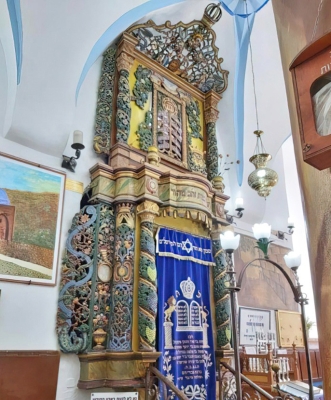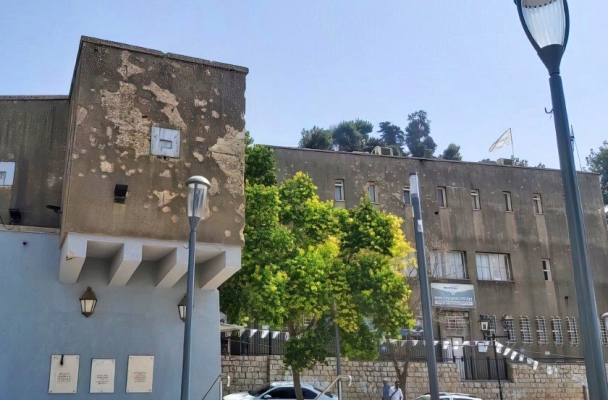Safed
 Local resident passes illustrated poster/words of ‘Yedid Nefesh’ — a song traditionally sung with Kabbalat Shabbat
Local resident passes illustrated poster/words of ‘Yedid Nefesh’ — a song traditionally sung with Kabbalat Shabbat
Text and photos by Lydia Aisenberg
Sitting 800 meters above sea level and commanding an area of stunning beauty, the city of Safed embraces visitors almost immediately with an incredible welcoming aura of mysticism, spirituality and historic richness – all of which deepens whilst wandering the ancient, unique Galilean city's abundance of attractive narrow winding alleyways and courtyards.
A constant thought during this writer's recent visit was "if only stones could speak!" Oh, what tales they would have to share with present day visitors walking over the shiny, smooth, ultra-worn cobblestones of the charismatic Old City, strong rays of the midday sun reflecting on the bright light and dark blue-painted walls, gates, metal and wooden doors.
The old part of Safed is indeed a place of almost instantly felt specialness and mystery, whatever one's degree of religious beliefs. Something special permeates the air, seems to gently waft out from every twist and turn between the low buildings and small courtyards where some of the greatest Kabbalists and teachers of Zohar lived, pondered and taught their knowledge, wisdom, interpretation and love of Judaism.
The Old City imbues one with a sense of it being something extraordinarily special, spiritual in a comfortable way. At the same time it nurtures awe and appreciation of the deep richness of Jewish history, culture, traditions and survival of the Jewish people through such disasters as earthquakes and plagues, and also having to fend off vicious attacks by Arabs.
Following the Spanish Inquisition and expulsion from Spain, many Spanish Jews made their way to Safed and settled there as the Mameluke era was drawing to a close and the Ottoman period began. The Sephardic newcomers used their talents and business acumen to transform the city into not only an important spiritual center but also a thriving commercial hub. One of the most commercial enterprises saw the development of a large textile industry, utilizing the fast flowing waters of the nearby Nachal Amud stream for the operation of mills – offering employment to many of the local community.
Apart from the Kabbalists, some of the most revered Sages, prominent rabbis, poets and scholars settled in the Galilean town, including Rabbi Moshe Cordovero; the Holy Ari, Rabbi Yitzchak Luria and his student Rabbi Chaim Vital; Rabbi Yosef Caro, author of the Shulchan Aruch, and the poets Rabbi Yisrael Nagara, composer of "Yah Ribon Olam," and Rabbi Shlomo Alkabetz, who composed "Lecha Dodi".
The Sephardi and Ashkenazi synagogues of Safed open their doors early in the morning so that those who wish to pray, or just enter in order to absorb their glorious, artistic and colorful all-embracing interiors, can do just that – and literally every week thousands do. Charity boxes outside some of the synagogues are, like in the Artists Quarter nearby, works of pure Judaica art in themselves.
When a companion commented they found the large number of donation-seeking vessels disturbing, another explained that the synagogues do not receive any government or municipal funding."The enormous number of visitors coming in and out all day has created the need for security and cleaning staff to be employed to ensure the welfare of these houses of worship," he explained.
In September 1918, when British Forces under General Edmund Allenby ousted the Turkish Army from Safed, the town's population was around 9,000 – around 5,000-plus Muslims, almost 3,000 Jews and 350 Christians. The relations between the different populations in Safed was known to be relatively good until the 1929 Arab nationalist movement instigated riots throughout the land, during which time local Arabs launched an assault on the Jewish quarter, killing several of their Jewish neighbors.
A long, straight stairway was created by the British – and some small houses were demolished for this purpose – towards the end of the 1936-1939 Arab riots, in order to create a buffer zone between the Jewish and Arab quarters. It was controlled by a British gun emplacement above the post office on Jerusalem Street, and an enormous searchlight alongside lit the stairs at night. The searchlight is still in place today.
In 1948 those stairs were considered the most dangerous defense line of the Jewish Quarter, earning the nickname "Stalingrad Line". In present times the flights of stone stairs leading down from Jerusalem Street under the former British police station, post office and searchlight, is known as"Ma'alot Oley HaGardom," named after seven Etzel fighters who were executed by the British in Acre (Akko) prison in 1947 and buried in Safed.
When the British evacuated the town prior to the 1948 War of Independence, only 2,000 of the 12,000 local Safed residents were Jews. The British allowed over 4,000 Arab fighters, including some troops from the Iraqi and Lebanese armies, to take over the two large, fortified police stations known as Teggart Forts. One of these forts – its outer walls still full of bullet holes incurred during the fierce 1948 battle for Safed – is situated opposite the present day Safed Municipality offices on the main road above the Jewish Quarter, and a short distance away from the infamous "Davidka". The "Davidka" was an extremely loud mortar devised by Jewish fighters during the 1948 war to scare the Arab armies with its ear-splittingly loud noise. Miracle of miracles, it did the job extremely well, as the Arab fighters fled fearing the Jewish fighters had a new weapon of mass destruction.









Comments